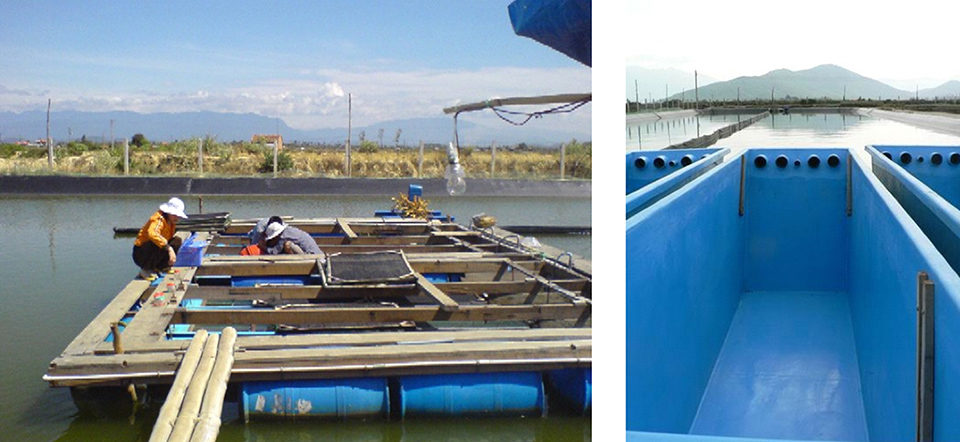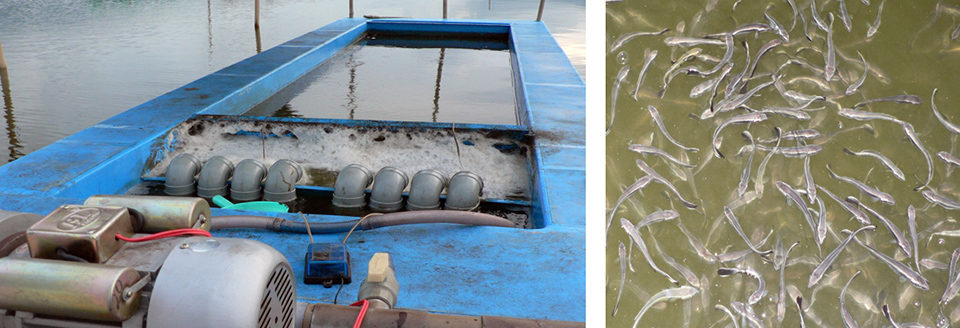Method can maximize resource utilization, develop polyculture and limited-discharge systems

The rapid development of marine finfish farming in Vietnam requires large numbers of large-sized fingerlings for stocking in sea cages or coastal ponds. However, local seed production of important culture species such as Epinephelus coioides and E. malabaricus groupers, cobia (Rachycentron canadum) and barramundi (Lates calcarifer) has had limited impact on fish farming due to the low survival rates of the small fish raised.
The production of larger 10- to 15-cm fish in hatchery tanks is considered very costly, not to mention its limitation in scale. Pond production is not reliable – poor fish survival and husbandry challenges are commonly reported by farmers who nurse fish in coastal ponds. Therefore, the development of cost-effective nursing systems is needed to overcome these limitations of traditional nursing systems. Floating raceways offer a potential solution.
Floating raceways
Floating raceways for freshwater fish farming were recently trialed successfully in the United States, Germany, and Australia. Despite their relatively high capital and operating costs, the raceways have a number of advantages, including the support of high stocking densities without predation and effective disease and feeding management that takes advantage of natural food in ponds. Floating raceways also have limited labor requirements.
The application of floating raceways in existing coastal ponds can not only maximize resource utilization, but also open chances for the further development of polyculture and limited-discharge systems when combined effectively with bioremediation or biofloc technology.
In Vietnam, a project coordinated by the Ministry of Agriculture and Rural Development of Vietnam and sponsored by the Collaborative Agriculture Research & Development Program of Vietnam and Australia addressed the design and testing of several floating raceway systems. The development and initial implementation of the Smart Mariculture Technology (SMART) project were supported by Dr. Adrian Collins and Benjamin Russels.
Working principles
The working principles of floating raceways are relatively simple. Typically made of fiberglass, they are quite light and look like a long, narrow tank that floats in water, with or without additional flotation devices. Raceways can be placed in ponds, reservoirs, or sheltered waters.
Outside water is continuously circulated through SMART thanks to an airlift system operated by a central air blower. This helps limit electricity costs and enhance dissolved oxygen levels.
Fish are nursed or grown in raceways at high densities and fed formulated feed. In addition, the incoming water brings in natural plankton that can be an important supplementary feed source for small fish. Screen is installed at raceway outlets to keep fish from escaping, and netting covers the raceway surface to protect fish from predation.
In SMART raceways, a baffle is mounted right after the airlift system to direct water flow toward the bottom. This enables easy waste collection at the end of the raceway and creates a quiet area for feeding.
When chemical application is needed for disease treatment, the airlift system can be turned off and the raceway outlet temporarily blocked to turn the raceway into a static tank with oxygen supply supplemented by airstones. This arrangement also makes fish grading simple and less stressful. A hard net of chosen mesh size can be used to push fish from one end of the raceway to the other. For harvesting, a soft net is used.

Designs, performance
In 3-cubic-meter raceway units stocked with 10,000 to 20,000 15- to 20-mm barramundi fingerlings, the fish have reached 40 to 45 mm in 10 days and 100 to 120 mm in 30 days at water temperatures of 30 to 32 degrees-C. Survival to 30 days ranged 70 to 85 percent, mainly because of cannibalism. Profit return ranged 0.5 to 1.4, demonstrating high profitability for this nursing system. Cobia, groupers, mangrove jacks, and red drum have also been successfully raised in floating raceways.
The authors are testing 6-cubic-meter raceway tanks at commercial scale for fingerling production of cobia and groupers in coastal ponds, and monosex tilapia and eels in freshwater ponds. Such units would cost about U.S. $2,000 and stock up to 40,000 barramundi fingerlings.
Modular 10-cubic-meter raceways could handle 20,000 to 30,000 cobia of 120- to 150-mm length for fingerling production. The raceway units could also be towed by boat to transport fish in coastal areas.
Floating raceways placed in coastal areas with supreme natural water quality could potentially be used to nurse the phyllosoma larvae of spiny rock lobsters (Panulirus ornatus). To minimize operating expense, solar or wind energy could operate the pumps to bring both water and natural food to the young animals.
(Editor’s Note: This article was originally published in the July/August 2007 print edition of the Global Aquaculture Advocate.)
Now that you've finished reading the article ...
… we hope you’ll consider supporting our mission to document the evolution of the global aquaculture industry and share our vast network of contributors’ expansive knowledge every week.
By becoming a Global Seafood Alliance member, you’re ensuring that all of the pre-competitive work we do through member benefits, resources and events can continue. Individual membership costs just $50 a year. GSA individual and corporate members receive complimentary access to a series of GOAL virtual events beginning in April. Join now.
Not a GSA member? Join us.
Authors
-
Dr. Tung Hoang
International Center for Training & Research
Nha Trang University, Vietnam -
Michael Burke
Bribie Island Aquaculture Research Centre
Queensland Department of Primary Industries and Fisheries
Australia
Tagged With
Related Posts

Responsibility
Aquaponic system produces red drum, saltwater vegetable species
A project in Florida is studying the feasibility of a marine aquaponic system containing red drum and two native saltwater species. Water that exits the plant raceways is filtered and recirculated to the fish tanks. In tests, sea purslane grew rapidly, while saltwort took almost four months to adapt. The fish exhibited high survival and achieved a feed-conversion ratio of 1.2.

Intelligence
Bahamas venture focuses on grouper, other high-value marine fish
A new venture under development in the Bahamas will capitalize on Tropic Seafood’s established logistics and infrastructure to diversify its operations from processing and selling wild fisheries products to include the culture of grouper and other marine fish.

Intelligence
Commercial implementation of in-pond raceway system
An in-pond raceway system in Alabama was utilized to supply various niche markets, including Asian grocery store chains that desired fresh live fish, recreational pond stocking businesses, private pond owners and fee fishing operations. In many cases, a higher price was achieved.

Health & Welfare
Commercial demonstration of in-pond raceways
Results of a demonstration project of the In-Pond Raceway System (IPRS) technology in seven tilapia raceways at a commercial farm in Mexico showed the potential for increasing fish production with this environmentally sustainable culture system.


